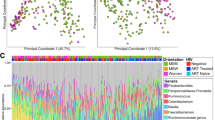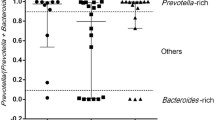Abstract
Tenofovir-based regimens as pre-exposure prophylaxis (PrEP) are highly effective at preventing HIV infection. The most common side-effect is gastrointestinal (GI) distress which may be associated with changes in the microbiome. Dysbiosis of the microbiome can have numerous health-related consequences. To understand the effect of PrEP on dysbiosis, we evaluated 27 individuals; 14 were taking PrEP for an average of 171 weeks. Sequencing of 16S rRNA was performed using self-collected rectal swabs. Mixed beta diversity testing demonstrated significant differences between PrEP and non-PrEP users with Bray–Curtis and unweighted UniFrac analyses (p = 0.05 and 0.049, respectively). At the genus level, there was a significant reduction in Finegoldia, along with a significant increase in Catenibacterium and Prevotella in PrEP users. Prevotella has been associated with inflammatory pathways, insulin resistance and cardiovascular disease, while Catenibacterium has been associated with morbid obesity and metabolic syndrome. Overall, these results suggest that PrEP may be associated with some degree of microbiome dysbiosis, which may contribute to GI symptoms. Long-term impact of these changes is unknown.
Resumen
Los regímenes basados en tenofovir como profilaxis previa a la exposición (PPrE) son muy eficaces en prevenir la infección por VIH. El efecto secundario más común es el malestar gastrointestinal (GI) que puede estar asociado con cambios en el microbioma. La disbiosis del microbioma puede tener numerosas consecuencias relacionadas con la salud. Para comprender el efecto de la PPrE sobre la disbiosis, evaluamos a 27 individuos; 14 de los individuos tomaron PPrE durante un promedio de 171 semanas. La secuenciación del ARNr 16S se realizó utilizando hisopos rectales recolectados por los propios pacientes. Las pruebas beta de diversidad mixta demostraron diferencias significativas entre los usuarios de PPrE y los que no utilizaron PPrE al analizarlos mediente Bray–Curtis y UniFrac no ponderados (p = 0,05 y 0,049, respectivamente). A nivel de género, hubo una reducción significativa de Finegoldia, junto con un aumento significativo de Catenibacterium y Prevotella en usuarios de PPrE. Prevotella se ha asociado con trayectorias inflamatorias, resistencia a insulina y enfermedades cardiovasculares, mientras que Catenibacterium se ha asociado con enfermedades como obesidad mórbida y padecimientos de síndrome metabólico. En general, estos resultados sugieren que la PPrE puede estar asociada con cierto grado de disbiosis del microbioma, lo que puede contribuir a los síntomas gastrointestinales. El impacto a largo plazo de estos cambios se desconoce.






Similar content being viewed by others
References
Maartens G, Celum C, Lewin S. HIV infection: epidemiology, pathogenesis, treatment, and prevention. Lancet. 2014;384(9939):19–25.
Grant RM, Lama JR, Anderson PL, et al. Preexposure chemoprophylaxis for HIV prevention in men who have sex with men. N Engl J Med. 2010;363:2587–99.
Solomon MM, Lama JR, Glidden DV. Changes in renal function associated with oral emtricitabine/tenofovir disoproxil fumarate use for HIV pre-exposure prophylaxis. AIDS. 2014;28(6):851–9.
Gandhi M, Glidden DV, Mayer K, et al. Association of age, baseline kidney function, and medication exposure with declines in creatinine clearance on pre-exposure prophylaxis: an observational cohort study. Lancet HIV. 2016;3(11):e521–8.
Mulligan K, Glidden DV, Anderson PL, et al. Effects of emtricitabine/tenofovir on bone mineral density in HIV-negative persons in a randomized, double-blind, Placebo-Controlled Trial. Clin Infect Dis. 2015;61(4):572–80.
Villanueva- MJ, Perez-Matute P, Recio-Fernandez E, Lezana Rosales JM, Oteo JA. Differential effects of antiretrovirals on microbial translocation and gut microbiota composition of HIV-infected patients. J Int AIDS Soc. 2017;20(1):21526.
Klatt NR, Funderburg NT, Brenchley JM. Microbial translocation, immune activation, and HIV disease. Trends Microbiol. 2013;21:6–13.
Zevin AS, McKinnon L, Burgener A, Klatt NR. Microbial translocation and microbiome dysbiosis in HIV-associated immune activation. Curr Opin HIV AIDS. 2016;11:182–90.
Gootenberg DB, Paer JM, Luevano JM, et al. HIV-associated changes in the enteric microbial community: potential role in loss of homeostasis and development of systemic inflammation. Curr Opin Infect Dis. 2017;30(1):31–43.
Dubé MP, Park SY, Ross H, et al. Daily HIV pre-exposure prophylaxis (PrEP) with tenofovir disoproxil fumarate-emtricitabine reduced Streptococcus and increased Erysipelotrichaceae in rectal microbiota. Sci Rep. 2018;8(1):15212.
Fulcher JA, Li F, Cook RR, et al. Rectal microbiome alterations associated with oral human immunodeficiency virus pre-exposure prophylaxis. Open Forum Infect Dis. 2019;6(11):ofz463.
Noguera-Julian M, Rocafort M, Guillen Y, et al. Gut microbiota linked to sexual preference and HIV infection. EBioMedicine. 2016;5:135–46.
Kelley CF, Kraft CS, de Man TJB, et al. The rectal mucosa and condomless receptive anal intercourse in HIV negative MSM: implications for hiv transmission and prevention. Mucosal Immunol. 2017;10(4):996–1007.
Arumugam M, Raes J, Pelletier E, et al. Enterotypes of the human gut microbiome. Nature. 2011;473(7346):174–80.
Schincaglia GP, Hong BY, Rosania A, et al. Clinical, immune, and microbiome traits of gingivitis and peri-implant mucositis. J Dent Res. 2017;96(1):47–55.
Scher JU, Ubeda C, Equinda M, et al. Periodontal disease and the oral microbiota in new-onset rheumatoid arthritis. Arthritis Rheum. 2012;64(10):3083–94.
Moreno-Indias I, Sanchez-Alcoholado L, Garcia-Fuentes E, et al. Insulin resistance is associated with specific gut microbiota in appendix samples from morbidly obese patients. Am J Transl Res. 2016;8(12):5672–84.
Mugwanya KK, Baeten JM. Safety of oral tenofovir disoproxil fumarate-based pre-exposure prophylaxis for HIV prevention. Expert Opin Drug Saf. 2017;15(2):265–73.
Petersen C, Round JL. Defining dysbiosis and its influence on host immunity and disease. Cell Microbiol. 2014;16(7):1024–33.
Binda C, Lopetuso LR, Rizzatti G, et al. Actinobacteria: a relevant minority for the maintenance of gut homeostasis. Dig Liver Dis. 2018;50(5):421–8.
Budding AE, Grasman ME, Eck A, et al. Rectal swabs for analysis of the intestinal microbiota. PLoS ONE. 2014;9(7):e101344.
Biehl LM, Garzettia D, Farowski F, et al. Usability of rectal swabs for microbiome sampling in cohort study of hematological and oncological patients. PLoS ONE. 2019;14(4):e0215428.
Caporaso JG, Kuczynski J, Stombaugh J, et al. QIIME allows analysis of high-throughput community sequencing data. Nat Methods. 2010;7:335–6.
Caporaso JG, Lauber CL, Walters WA, et al. Ultra-high-throughput microbial community analysis on the Illumina HiSeq and MiSeq platforms. ISME J. 2012;6(8):1621–4.
Walters W, Hyde ER, Berg-Lyons D, et al. Improved bacterial 16S rRNA gene (V4 and V4–5) and fungal internal transcribed spacer marker gene primers for microbial community surveys. mSystems. 2016;1(1):e00009-e00015.
Thompson LR, Sanders JG, McDonald D, et al. A communal catalogue reveals Earth’s multiscale microbial diversity. Nature. 2017;551(7681):457–63.
Callahan BJ, McMuride PJ, Rosen MJ, et al. DADA2: high resolution sample inference from Illumina amplicon data. Nat Methods. 2016;13(7):581–3.
Gurevich A, Saveliev V, Vyahhi N, et al. QUAST: quality assessment tool for genome assemblies. Bioinformatics. 2013;29(8):1072–5.
Segata N, Izard J, Waldron L, et al. Metagenomic biomarker discovery and explanation. Genome Biol. 2011;12(6):R60.
Hassan A, Blumenthal JS, Dube MP, et al. Effect of rectal douching/enema on rectal gonorrhoea and chlamydia among a cohort of men who have sex with men on HIV Pre-exposure prophylaxis. Sex Transm Infect. 2018;94(7):508–14.
Haaland RE, Fountain J, Hu Y, et al. Repeated rectal application of a hyperosmolar lubricant is associated with microbiota shifts but does not affect PrEP drug concentrations: results from a randomized trial in men who have sex with men. J Int AIDS Soc. 2018;21(10):e25199.
Zhernakova A, Kurilshikov A, Bonder MJ, et al. Population-based metagenomics analysis reveals markers for gut microbiome composition and diversity. Science. 2016;352(6285):565–9.
Armstrong AJS, Shaffer M, Nusbacher NM, et al. An exploration of Prevotella-rich microbiomes in HIV and men who have sex with men. Microbiome. 2018;6:198.
Gallardo-Becerra L, Cornejo-Granados F, Lopez-Garcia R, et al. Metatranscriptomic analysis to define the Secrebiome, and 16S rRNA profiling of the gut microbiome in obesity and metabolic syndrome of Mexican children. Microb Cell Fact. 2020;19:61.
Carda-dieguez M, Cardenas N, Aparicio M, et al. Variations in vaginal, penile, and oral microbiota after sexual intercourse: a case report. Front Med (Lausanne). 2019;6:178.
Price LB, Liu CM, Johnson KE, et al. The effects of circumcision on the penis microbiome. PLoS ONE. 2010;5(1):e8422.
Liu CM, Prodger JL, Tobian AAR, et al. Penile anaerobic dysbiosis as a risk factor for HIV infection. mBio. 2017;4:e00996-e1017.
Flygel TT, Sovershaeva E, Claassen-Weitz S, et al. Composition of gut microbiota of children and adolescents with perinatal human immunodeficiency virus infection taking antiretroviral therapy in zimbabwe. J Infect Dis. 2020;221(3):483–92.
Nowak RG, Bentzen SM, Ravel J, et al. Rectal microbiota among HIV-uninfected, untreated HIV, and treated HIV-infected men who have sex with men (MSM) in Nigeria. AIDS. 2017;31(6):857–62.
Funding
P.B. and EH were supported by the U.S. Department of Defense through the Peer Reviewed Medical Research Program under award number W81XWH-18-1-0198, by the National Center for Complementary & Integrative Health of the NIH Award Number R21AT010366, and by institutional development awards P20GM121344 received from the National Institute of General Medical Sciences. The funding agencies had no role in the design of the study or the collection, analysis, and interpretation of data. The authors would like to specifically thank Caroline Keroack for her thoughtful feedback during the editing process.
Author information
Authors and Affiliations
Contributions
All authors contributed to the study conception and design. Material preparation was performed by BKP, PAC, JS, MM, and PB. Data collection was performed by BKP, MM and MM. Data analysis was performed by BKP and EMR. The first draft of the manuscript was written by BKP and EMR and all authors commented on previous versions of the manuscript. All authors read and approved the final manuscript.
Corresponding authors
Ethics declarations
Conflict of interest
The authors declare that they have no competing interests.
Ethical Approval
The study was reviewed and approved by the Institutional Review Board of The Miriam Hospital, a Lifespan affiliated hospital. All procedure performed in the studies involving human subjects were in accordance with the ethical standards of the institutional and/or national research committee and with the 1964 Helsinki Declaration and its later amendments or comparable ethical standards.
Informed Consent
Informed consent was obtained from all individuals participants including in the study.
Additional information
Publisher's Note
Springer Nature remains neutral with regard to jurisdictional claims in published maps and institutional affiliations.
Supplementary Information
Below is the link to the electronic supplementary material.
10461_2020_3130_MOESM1_ESM.docx
Supplemental File 1: Survey. This 17-point questionnaire obtained demographic, lifestylebehavioral, and sexual practice information from each participant over the past 3 months leadingup to enrollment. (DOCX 20 kb)
Rights and permissions
About this article
Cite this article
Perler, B.K., Reinhart, E.M., Montgomery, M. et al. Evaluation of the Microbiome in Men Taking Pre-exposure Prophylaxis for HIV Prevention. AIDS Behav 25, 2005–2013 (2021). https://doi.org/10.1007/s10461-020-03130-7
Accepted:
Published:
Issue Date:
DOI: https://doi.org/10.1007/s10461-020-03130-7




